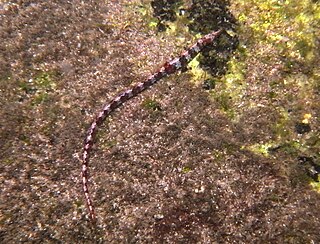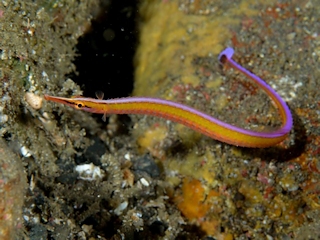
Pipefishes or pipe-fishes (Syngnathinae) are a subfamily of small fishes, which, together with the seahorses and seadragons, form the family Syngnathidae.
The Zavora pipefish is a species of marine fish of the family Syngnathidae. It is only known from three specimens found in the Western Indian Ocean, one from Zavora, Mozambique and two from Sur, Oman. Little is known about its habitat or feeding habits, but they are expected to feed on small crustaceans similar to other pipefish. It can grow to at least 10 centimetres (3.9 in) in length. This species is ovoviviparous, with males carrying eggs and giving birth to live young.
Earl Stannard Herald was an American zoologist, Ichthyologist and television presenter. He was born in Phoenix, Arizona, and got his Ph.D. in 1943. In 1948, he became the director of the Steinhart Aquarium in San Francisco, California, and from 1952 to 1966, he presented the popular science television programme Science in Action. Throughout his life, he studied a variety of aquatic organisms, especially pipefishes, and described many new taxa. He died in Cabo San Lucas, Baja California, in a scuba diving accident.

Lissocampus caudalis, also called the Australian smooth pipefish or the smooth pipefish, is a species of marine fish belonging to the family Sygnathidae.
Microphis insularis, also known as the Andaman pipefish, is a species of freshwater pipefish belonging to the family Sygnathidae. This species is found only in rivers and streams located in the Andaman Islands, India. They can reach 16 cm (6.3 in) in length and reproduce through ovoviviparity, in which males carry eggs and give live birth. The Andaman pipefish is considered threatened likely due to the effects of habitat degradation, invasive species, and the alteration of flow of its freshwater habitats.

Ichthyocampus carce, also known as the freshwater pipefish or Indian freshwater pipefish is a species of marine fish belonging to the family Syngnathidae. It can be found mainly in freshwater streams, rivers, and estuaries located in the Indian Ocean and West Pacific, from Indonesia to the western coast of India. It can live in both inland and coastal waters. This species can grow to a length of 15cm and feeds primarily on small invertebrates and zooplankton. Reproduction occurs through ovoviviparity, in which the males carry eggs in a brood pouch before giving live birth. Males of this species can brood roughly 280 offspring at a time.
Hypselognathus rostratus, also known as the knife-snouted pipefish is a species of marine fish belonging to the family Syngnathidae. This species can be found in very shallow coastal waters of southeastern Australia. Their habitat consists of sandy substrates, seagrass beds, and estuaries. Reproduction occurs through ovoviviparity in which the males brood eggs before giving live birth.
Lissocampus fatiloquus, also known as prophet's pipefish is a species of marine fish belonging to the family Syngnathidae. The species has been noted in a variety of habitats including sargassum, seagrass beds and sandy substrates along the coast of Western Australia from Shark Bay to Rottnest Island. Their diet is thought to consist of small crustaceans such as copepods. Reproduction occurs through ovoviviparity in which the males brood eggs before giving live birth.

Lissocampus runa, also known as the javelin pipefish is a species of marine fish belonging to the family Syngnathidae. This species can be found in algae beds, rocky reefs, tidepools, and estuaries along the coast of southern Australia from Broken Head Nature Reserve in New South Wales to Rottnest Island, Western Australia. Their diet is thought to consist of small crustaceans such as copepods. Reproduction occurs through ovoviviparity in which the males brood eggs before giving live birth.
Penetopteryx taeniocephalus, also known as the oceanic pipefish is a species of marine fish belonging to the family Syngnathidae. The species can be found inhabiting coral rubble and gravel in many areas of the Indo-Pacific including Madagascar, Mauritius, the Philippines, Indonesia, and Vanuatu. Its diet likely consists of small crustaceans such as copepods. Reproduction occurs through ovoviviparity in which the males brood eggs before giving live birth.

Maroubra yasudai, also known as the orange pipefish, is a species of marine fish belonging to the family Syngnathidae. This species can be found in the Izu Oceanic Park along the coast of Honshu Island, Japan. They often inhabit rocky crevices and caves at depths ranging from 28 to 30 meters. Their diet likely consists of small crustaceans such as copepods. Reproduction occurs through ovoviviparity in which the males brood eggs before giving live birth.
Phoxocampus belcheri, also known as the rock pipefish, is a species of marine fish belonging to the family Syngnathidae. The species can be found in shallow reefs and tide pools throughout much of the Indo-Pacific ranging from the eastern coast of Africa and the Red Sea to Tonga and Japan. Its diet likely consists of small crustaceans such as copepods. Reproduction occurs through ovoviviparity in which the males brood eggs before giving live birth.
Phoxocampus diacanthus, also known as the obscure pipefish or spined pipefish, is a species of marine fish belonging to the family Sygnathidae. It can be found inhabiting reefs throughout the Indo-Pacific from Japan and Sri Lanka to Samoa and New Caledonia in the south. Its diet likely consists of small crustaceans. Reproduction occurs through ovoviviparity in which the males brood eggs before giving live birth.
Stigmatopora nigra, also known as the wide-bodied pipefish is a species of marine fish belonging to the family Syngnathidae. This species can be found in the shallow waters, bays, and estuaries of southern Australia from Shark Bay to Brisbane, Tasmania, and New Zealand. They often inhabit seagrass or algae beds in addition to bare sand. Their diet consists of small crustaceans such as copepods and amphipods. Adult brooding males have been measured at 6.5-7 centimeters. Reproduction occurs through ovoviviparity. in which the males brood up to 25 eggs in a pouch below the tail before giving live birth. Stigmatopora nigra can live to 150 days old and are able to reproduce throughout the year.
Urocampus carinirostris, also known as the hairy pipefish, is a species of marine fish belonging to the family Syngnathidae. They can be found inhabiting shallow seagrass beds and estuaries in Papua New Guinea and along the southern coast of Australia from Queensland to Swan River, Western Australia. Urocampus carinirostris is an ambush predator that is most commonly found on the edges of protected seagrass beds and near mangrove. Its diet consists of copepods and other small crustaceans. Reproduction occurs through ovoviviparity in which males brood around 48 eggs in a pouch beneath their tail before giving live birth to fully formed offspring. Adults can breed for at least six months.

Trachyrhamphus bicoarctatus, also known as the double-ended pipefish is a species of marine fish belonging to the family Syngnathidae. They can be found in reefs, seagrass beds, and sandy habitats throughout the Indo-Pacific from East Africa to New Caledonia and from Japan to Australia. Males of this species are considered mature when they reach approximately 26 centimeters long, but adults can grow to be lengths of 40 centimeters. Reproduction occurs through ovoviviparity in which males brood eggs before giving live birth.

Trachyrhamphus serratus, also known as the crested pipefish or saw pipefish, is a species of marine fish belonging to the family Syngnathidae. They can be found in Sargassum beds, mud, and sandy habitats from Southern India to South Korea and Japan. This species is observed at depths ranging from 15 to 100 meters.
Nannocampus pictus, also known as the reef pipefish is a species of marine fish belonging to the family Syngnathidae. They can be found inhabiting reefs and seagrass beds of the western Indian Ocean and the eastern coast of Australia including the Great Barrier Reef. Members of this species can grow to lengths of 10 cm and their diet likely consists of small crustaceans such as copepods. Reproduction occurs through ovoviviparity in which the males brood eggs before giving live birth.
Nannocampus subosseus, also known as the bony-headed pipefish is a species of marine fish belonging to the family Syngnathidae. They can be found inhabiting reefs and tide pools only in the region of Shark Bay to Esperance, Western Australia. Members of this species can grow to lengths of 12 cm and their diet likely consists of small crustaceans such as copepods. Reproduction occurs through ovoviviparity in which the males brood eggs before giving live birth.

Vanacampus phillipi, also known as the Port Phillip pipefish is a species of marine fish belonging to the family Syngnathidae. They can be found inhabiting seaweed and seagrass beds along the southern coast of Australia from Perth to Jervis Bay, New South Wales including the coast of Tasmania. Their diet consists of small crustaceans such as copepods, amphipods, and mysid shrimps. Reproduction occurs through ovoviviparity in which the males brood eggs before giving live birth to 50 or less offspring.








